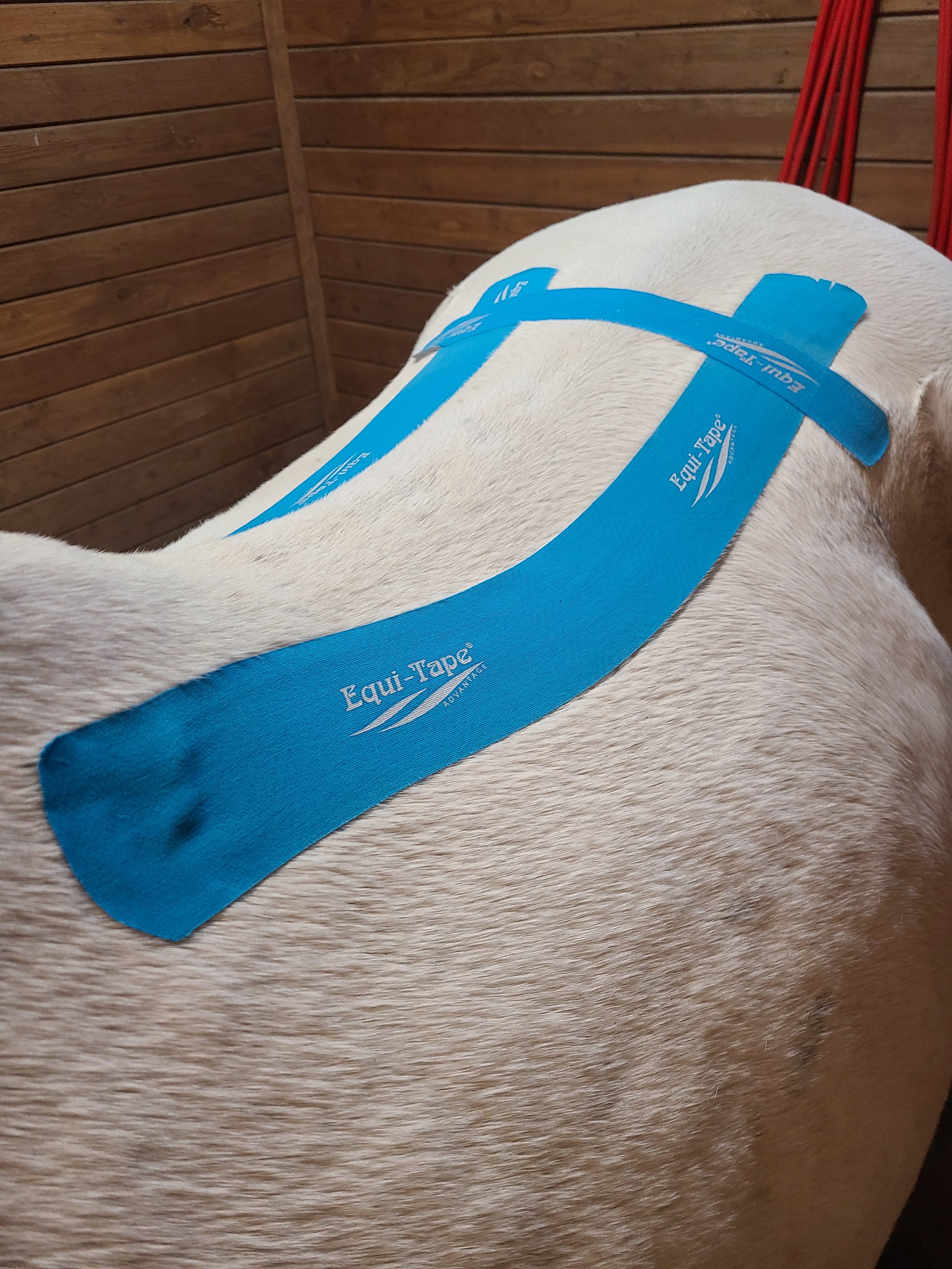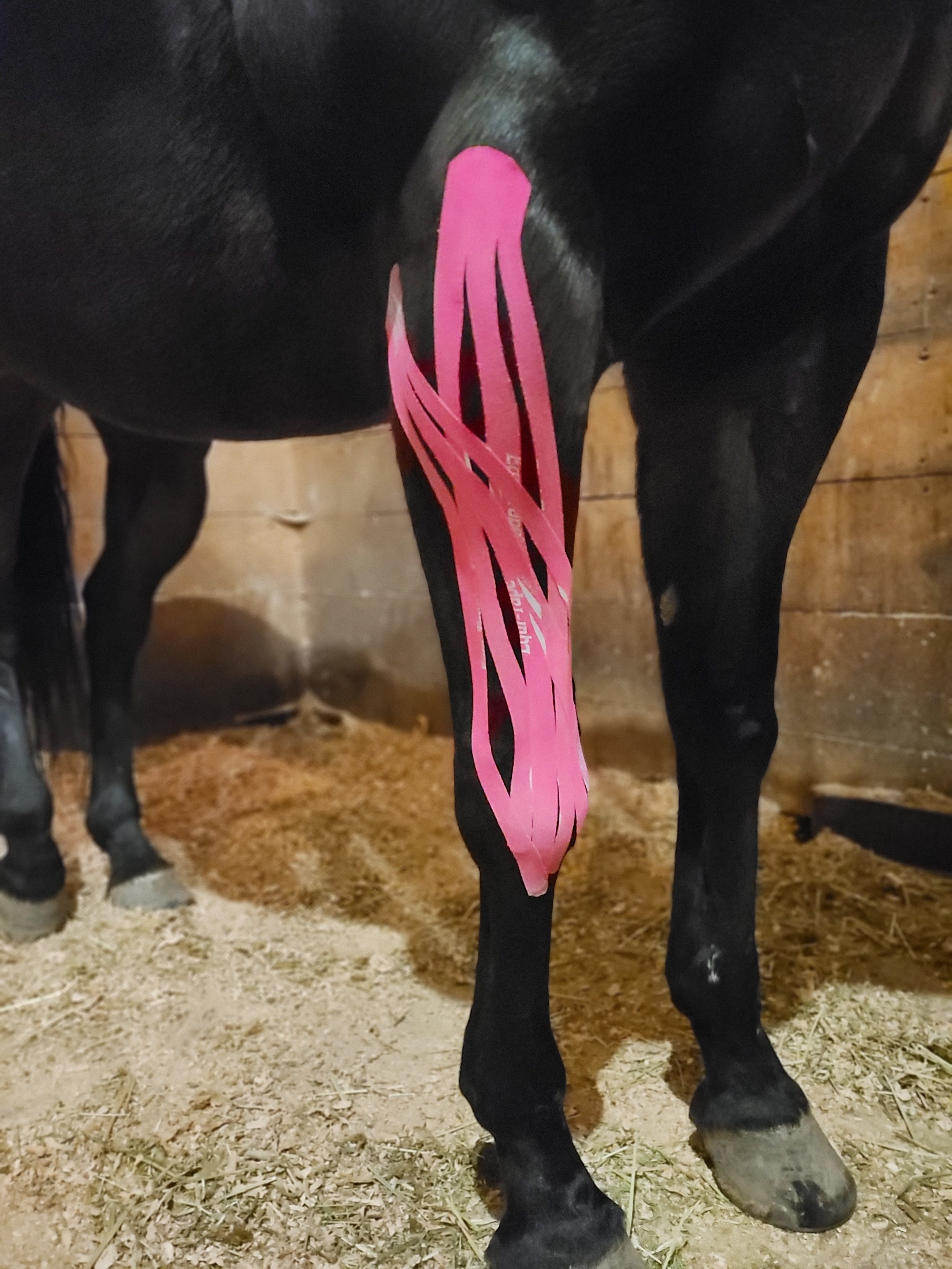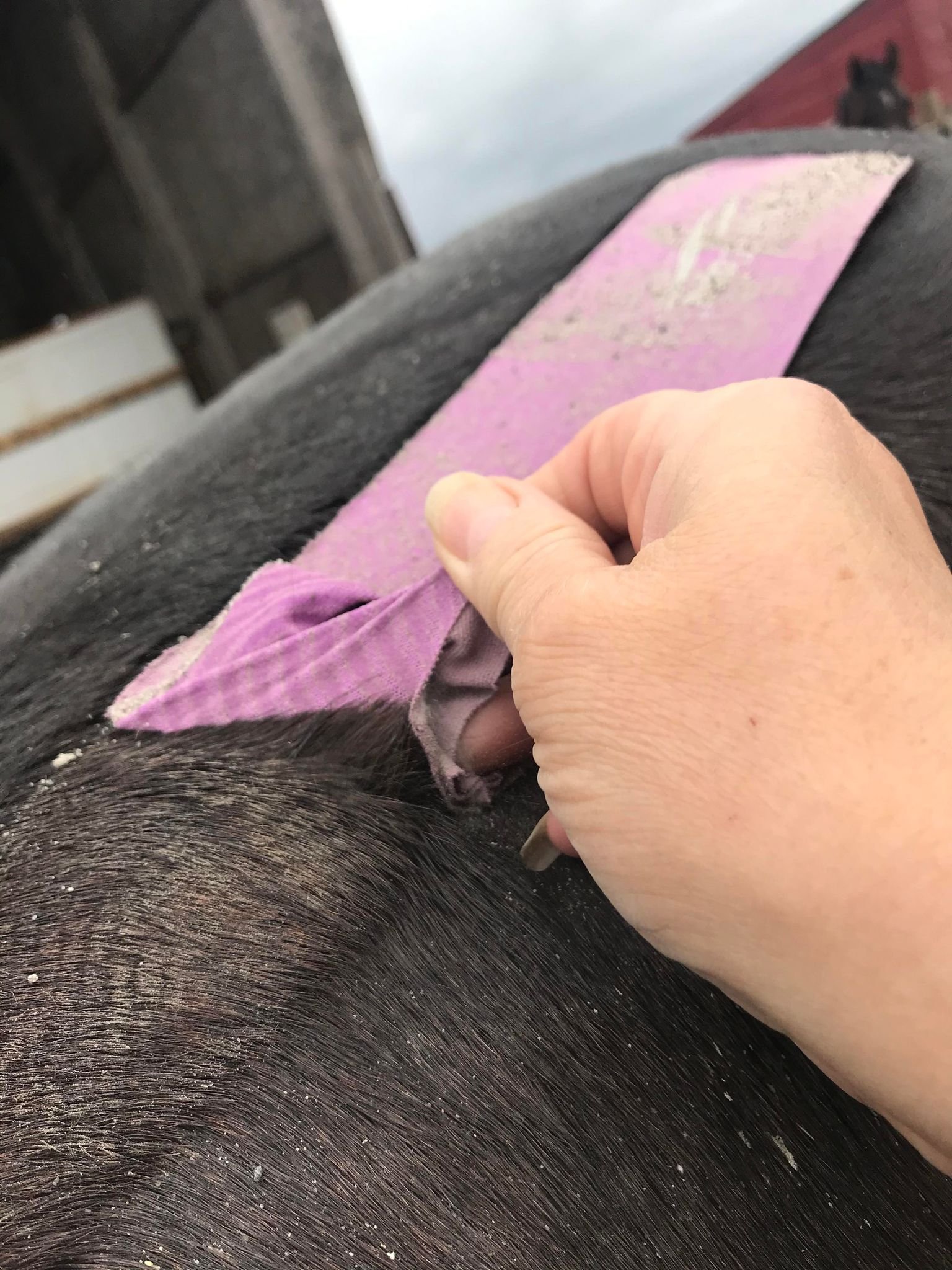Since I began to utilize equine kinesiology tape in my bodywork sessions, I’ve been getting a lot of questions about what the tape does and how best to use it.
Here are my answers to the most common questions about k-tape for horses. Please let me know if you have additional questions and I will answer them, or direct you to other resources!
1. What does it do?
Equine kinesiology tape, or k-tape, is extremely versatile and can do many things for your horse - regardless of their workload. Athlete in training, pasture pet or anything in between, kinesiology tape can:
Sacroiliac joint support tape application.
Encourage relaxation of soft tissues (muscle and fascia) that are tight and sore.
Help to decrease pressure on mechanoreceptors in the skin to relieve discomfort.
Help to break the pain cycle for injured horses or horses in chronic pain.
Improve blood and lymph circulation for injury recovery, and aid muscle recovery after exercise.
Add proprioceptive support for joints, tendons, and ligaments when healing from an injury or when in training.
Aid in facilitating positive postural changes and correct biomechanics (body movement) through proprioception (body awareness). Improve performance and recovery through muscle re-education.
2. How does it work?
Equine k-tape is an elastic kinesiology tape and protocol developed specifically for horses. Kinesiology taping has been a popular therapeutic modality for human athletes for a long time - even for people competing at the Olympic level - and is now becoming mainstream in the horse world. Equine kinesiology tape is created with specific materials, adhesives, and stretch to interact with the horse’s hair follicles, skin, and nervous system.
In its simplest form, k-tape interacts with the horse’s nervous system - the nerves perceive the qualities and positioning of the tape and send feedback to the brain, allowing the brain to signal changes in the body. When k-tape interacts with the hair root and nerve endings in the skin through a lifting sensation caused by the recoil effect of the elastic in the tape, decompression of the underlying tissues allows for increased fluid flow (blood, lymph) and delivery of oxygen. This tissue decompression also provides relief from soft tissue discomfort by decreasing pressure on the mechanoreceptors in the skin.
Kinesiology tape is lightweight and very elastic, and it is designed to move WITH the horse - it does not restrict their movement. This makes it ideal for rehabilitation, therapy, and training, when we want to encourage range of motion and proper biomechanics. Kinesiology tape is not the same as vet wrap, standing bandages, gaffer/duct tape, or first aid tape.
3. What are the benefits?
Back relaxation taping with lumbar support.
Kinesiology tape is a non-invasive and low-risk modality to achieve the benefits listed above. Horses are usually content to relax while it is applied, and find the tape comfortable to wear. They will often fall asleep, lick, chew and yawn while I’m applying the tape.
You can blanket, ride, and do all of your usual activities while the horse is wearing their kinesiology tape.
It is relatively simple to learn how to apply kinesiology tape, and owners can easily be taught how to re-apply an application on their own horse.
Applying kinesiology tape after a bodywork session can help to extend the benefits of the manual therapy beyond the length of the session.
Modern equine kinesiology tapes are made to withstand cold, wet, and long winter hair coats.
Kinesiology tape has scientific research and studies backing its use. There are new studies emerging frequently about the use of kinesiology tape specifically on horses. While some of the physiological effects of tape are still not fully understood, the newest findings are exciting and kinesiology tape users all over the world are experiencing positive effects for their horses.
4. How do you use tape in your sessions?
Circulation application for a swollen knee.
I utilize k-tape during my equine therapy sessions on an as-needed basis if I feel the horse could benefit from a particular application. Re-application visits can be arranged if appropriate.
Your horse’s first kinesiology taping will be included (complimentary) in their equine therapy session, to give you and your horse a chance to experience the many benefits of k-tape. After that, there is a charge for small, medium, and large applications. Please contact me directly for more information!
Individual rolls of kinesiology tape can be purchased from me if you’d like to tape your own horse. I can also direct you to online retailers.
5. What do I need to do to prepare my horse for kinesiology taping? What are some tips for keeping it in place?
This k-tape application has remained in place for a week. The horse is turned out in a field with herd mates and is not blanketed.
The “stickiness” of the tape can vary greatly depending on factors such as temperature and humidity, the oiliness of the individual horse’s coat, if they are shedding, products used on the horse’s coat, etc.
Ensure that your horse is dry. Please groom your horse thoroughly and do not use any coat sprays, conditioners or fly sprays prior to a kinesiology tape application. It is fine to use them after the tape has been applied.
Freshly clipped horses may not have enough hair coat for the tape to stick to.
The length of time that the tape should and will stay on will vary on the type of application, and this will be discussed at the appointment.
6. How do I remove the tape?
Remove the tape by picking on a corner and then slowly rolling the tape off the body in the direction of the hair. Do not pull the tape up and away from the body. It is ideal to wait for the tape to begin to come off on its own before removing it. If your horse is currently shedding, some hair will come off with the tape.
If you are having any trouble removing the tape comfortably from the horse, using a bit of coconut oil or baby oil on the adhesive can help to ease it off.
Gently rolling off the tape in the direction of the hair to remove it.
7. What are the considerations and contraindications for kinesiology taping?
Kinesiology tape should not be applied over sores, open wounds, skin irritations, bacterial infections, etc.
If your horse is ill or injured, please speak to your veterinarian before we apply kinesiology tape. This goes for any therapeutic service that I offer.
Testing the tape on your horse is recommended if your horse is extremely sensitive or has skin allergies/reactions. Reactions to the tape are very uncommon - the tape sits up and away from the skin on the hair coat, and the tape is designed to be safe for horses.
Horses that are turned out with others may have their tape removed by their herd mates. I have not experienced this myself, but if your horse is turned out with others, there is a risk of ingestion of the tape. Protecting the application with a blanket may be necessary in some cases.
As with any tool or supplement, check the rules with the correct authorities before you use kinesiology tape at a horse show.
8. How did you learn this modality?
Spot decompression tape application for a sore hip joint.
I completed the Equi-Tape Practitioners Course to become a certified Equi-Tape Practitioner. I plan to take continuing education courses to learn more advanced taping techniques, and my goal is to host workshops to teach owners how to use kinesiology tape on their own horses.
Contact me anytime if you are interested in trying k-tape for your horses, and have a look at my Equine Therapy page for more information and pricing.
Special thanks to Rhonda Doram for photos!







